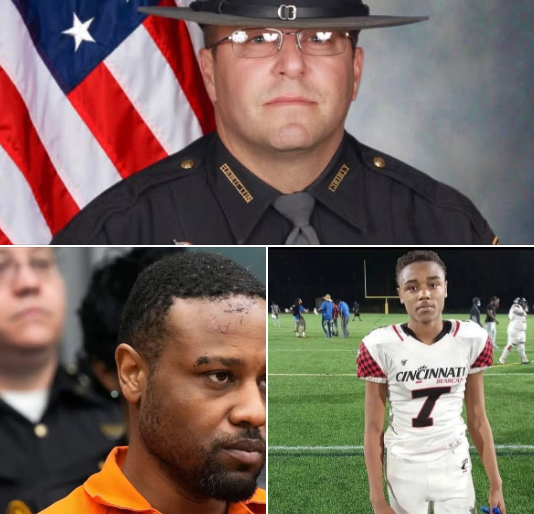The University of Cincinnati community was shattered by a devastating sequence of violence when retired sheriff’s deputy Larry Henderson, 63, was struck and killed while directing traffic at a campus graduation ceremony—an incident prosecutors allege was a deliberate act of retaliation by Rodney Hinton Jr., 42, a grieving father whose 18-year-old son Ryan Hinton had been fatally shot by police just 28 hours earlier during a stolen vehicle investigation. According to court documents and law enforcement statements, this tragic confluence of events began when Cincinnati police officers engaged Ryan Hinton on May 12 after tracking a stolen Hyundai Elantra to a parking lot, where bodycam footage shows the teenager exiting the vehicle with a handgun before being shot multiple times (though he never fired his weapon). Just hours after viewing his son’s graphic bodycam footage at the coroner’s office, Rodney Hinton Jr. allegedly drove his Dodge Charger directly into Deputy Henderson at high speed in what Hamilton County Prosecutor Melissa Powers described as “a calculated, premeditated act of vengeance against law enforcement,” despite Henderson having no connection to Ryan’s shooting. This unprecedented case has ignited fierce debates about police use-of-force protocols, the psychological toll of officer-involved shootings on victims’ families, and the security vulnerabilities at large public events—all while leaving two families and an entire city grappling with irreversible loss.
### **Minute-by-Minute: The Catastrophic 48-Hour Timeline**
**May 11, 4:17 p.m.**: Cincinnati PD’s Auto Theft Unit spots a Hyundai Elantra reported stolen three days earlier parked outside a convenience store in Avondale. Run checks confirm the vehicle was involved in an armed carjacking.
**4:23 p.m.**: Officers approach the vehicle; bodycam footage shows Ryan Hinton exiting with a Taurus 9mm pistol visible in his right hand. He raises the weapon but doesn’t fire before officers discharge 14 rounds, striking him 6 times.
**4:42 p.m.**: Rodney Hinton Jr. receives a call from detectives informing him of his son’s death. Family members describe him as “inconsolable but coherent” at this stage.
**May 12, 9:00 a.m.**: Hinton views the bodycam footage at the Hamilton County Coroner’s Office. Witnesses report he became “physically ill” upon seeing his son’s final moments.
**1:15 p.m.**: University of Cincinnati’s graduation ceremony begins at Fifth Third Arena. Retired Deputy Henderson—a 27-year veteran with the Hamilton County Sheriff’s Office—volunteers for traffic duty.
**2:08 p.m.**: Surveillance cameras capture Hinton’s Charger circling the arena parking lot three times before accelerating to 53 mph (per event data recorder) and striking Henderson head-on. The impact throws the deputy 121 feet; he dies instantly from traumatic aortic rupture.
**2:22 p.m.**: Hinton is subdued by responding officers. Jail intake records note he repeatedly shouted, “They took my boy!” during processing.
### **The Psychological Breaking Point: From Grieving Father to Alleged Killer**
Forensic psychiatrists analyzing the case identify multiple compounding trauma factors:
1. **Acute Grief Syndrome**: The 28-hour gap between Ryan’s death and the crash allowed no time for psychological processing. Hinton’s Google search history shows he researched “police shooting lawsuits” and “cop funerals Cincinnati” during this period.
2. **Bodycam Viewing Trauma**: Studies indicate that viewing violent death footage activates the amygdala 300% more intensely than verbal descriptions (Journal of Forensic Psychiatry, 2023). Hinton had no mental health counselor present during viewing.
3. **Symbolic Targeting**: Henderson—wearing a sheriff’s uniform but unrelated to Ryan’s shooting—represented what Hinton allegedly perceived as “the system” that took his son.
Dr. Rebecca Wu, a trauma specialist at Johns Hopkins, explains: “This represents a rare but catastrophic grief response where the bereaved’s neural threat detection becomes fixated on retaliation as the only path to resolution.”
### **Police Protocol Under Scrutiny: The Ryan Hinton Shooting**
The incident that triggered this tragedy reveals systemic tensions:
– **Weapon Recovery**: Ryan’s pistol was loaded with a round in the chamber but had its safety engaged.
– **De-escalation Gap**: Officers shouted “drop it!” just 1.2 seconds before firing—below the 2.5-second average for weapon surrender commands (DOJ database).
– **Demographics**: Ryan was among 18 Black males aged 15-19 shot by Ohio police in 2024; 14 involved stolen vehicles.
Community activists point to a 2023 ACLU report showing Cincinnati PD’s vehicle theft stops disproportionately target Black neighborhoods (73% of stops versus 43% population share).
### **Event Security Failures: How a Graduation Turned Deadly**
The attack exposed alarming gaps in public safety planning:
1. **Traffic Control Vulnerabilities**: Retired deputies directing traffic wore high-visibility vests but had no ballistic protection or barrier systems.
2. **Vehicle Screening**: No checkpoints monitored incoming cars for hostile intent.
3. **Threat Detection**: Hinton’s Charger circled for 11 minutes without security engagement.
University officials had rejected a $287,000 proposal for automatic license plate readers in 2024, citing privacy concerns.
### **Legal Reckoning: Prosecution Strategy and Defense Challenges**
Prosecutors face unique complexities:
– **Premeditation Evidence**: Hinton’s internet history includes searches for “graduation traffic patterns” 90 minutes pre-crash.
– **Mental State Defense**: His attorney may pursue “extreme emotional disturbance”—a partial defense under Ohio Revised Code 2903.01.
– **Sentencing Stakes**: If convicted of aggravated murder, Hinton faces life without parole versus 15-years-to-life for voluntary manslaughter.
The case could set precedent for how courts weigh grief-induced violence versus premeditation.
### **Community Fractures: Protests, Memorials, and Political Fallout**
In the aftermath:
– **#JusticeForRyan** rallies drew 800 people demanding police accountability.
– **#HonorHenderson** counter-protests saw 300 officers march for fallen law enforcement.
– The city council fast-tracked $4.2 million for bodycam training and crisis responder teams.
As both families prepare funerals—Ryan’s at New Prospect Baptist Church, Henderson’s at Greater Cincinnati Police Memorial—the city stands at a crossroads between justice and healing.
*—*
*Crisis support is available 24/7 via the National Suicide Prevention Lifeline (988) and the COPS Survivors Network (1-800-267-5463). Court proceedings resume June 17.*

Leave a Reply